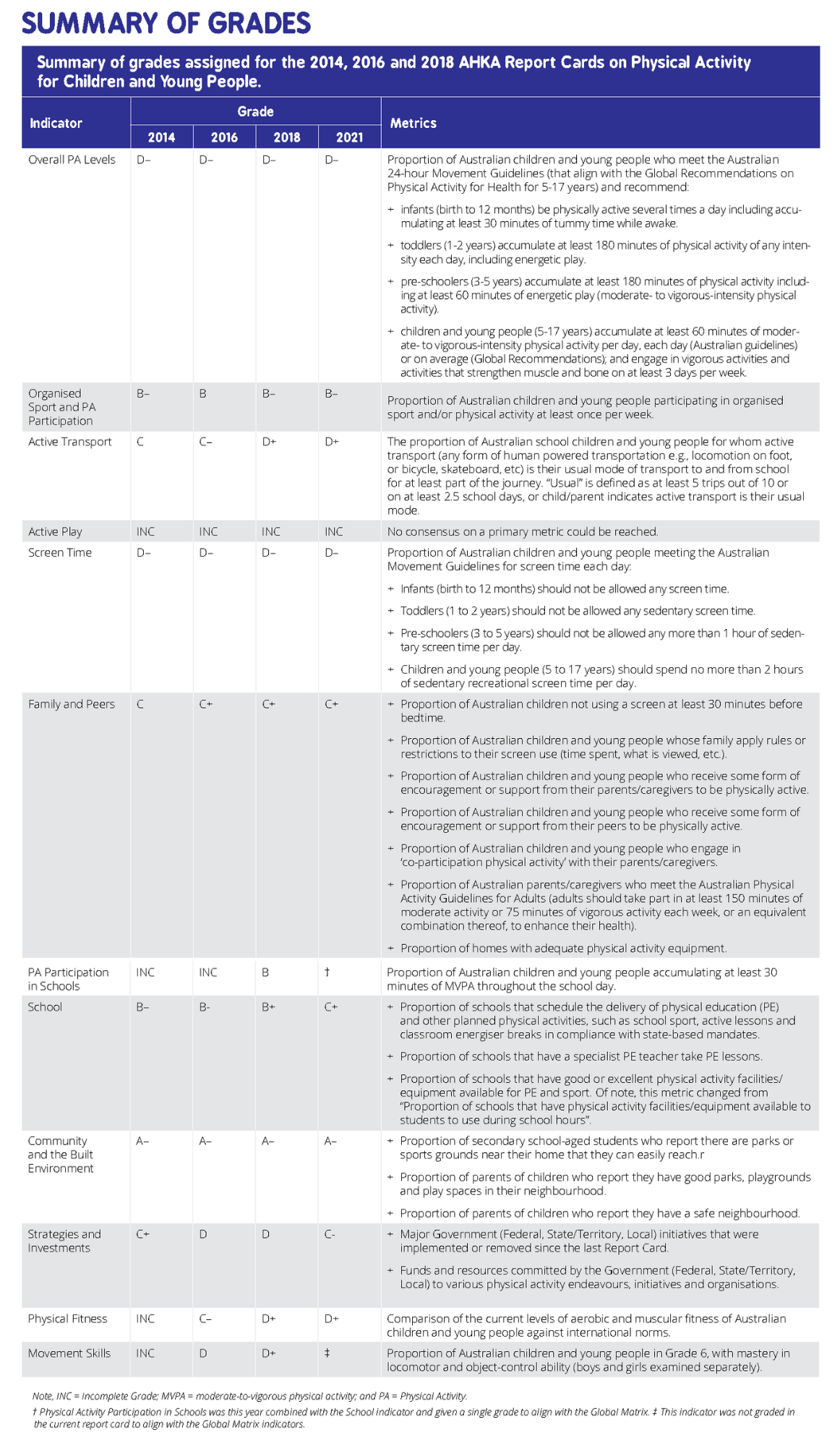2022 Australian Physical Activity Report Card released
 The 2022 Active Healthy Kids Australia Report Card has been released by the Australasian Society for Physical Activity (ASPA) and leading universities and research institutes across Australia.
The 2022 Active Healthy Kids Australia Report Card has been released by the Australasian Society for Physical Activity (ASPA) and leading universities and research institutes across Australia.
The Report Card combines national and state/territory representative data on ten indicators of children’s physical activity.
By monitoring and advocating for higher physical activity levels and supports for children and young people, the Report Card highlights unique opportunities for social change to help foster more physically active lives for all.
Australia’s score for overall physical activity in 2022 is D-. This has remained largely unchanged from 2018 and signifies a general lack of improvement in Australia’s physical activity benchmarks since the Report Card initiative began in 2014.

Our score of D- means fewer than one quarter of Australian children are meeting the national guidelines for the recommended levels of daily physical activity needed for optimal health and wellbeing.
These indicators and our scores for 2022 are: Overall Physical Activity (D-), Organised Sport and Physical Activity Participation (B-), Active Transport (D+), Screen Time (D-), Family and Peers (C+), Community and the Built Environment (A-), and Physical Fitness (D+). Active Play again received a grade of inconclusive due to inadequate national benchmark and data to assess this indicator.
Anecdotally these results can partly be attributed to the global COVID-19 pandemic. While restrictions brought about by the pandemic generally resulted in children being less physically active than before, there have also been changes in how children are physically active. It is these changes and advances that hold promise for children’s physical activity moving forward.
The theme of this year’s Report Card, ‘REBOOT! Reimagining physically active lives’, highlights the opportunities the pandemic has exposed as a catalyst to reconsider and reboot the conversation around physical activity levels, and how to create more physically active lifestyles for everyone.
So, what can schools do?
Physically active kids are happy, healthy, and resilient kids. Active kids are also active learners. Active kids are also more likely to become active adults, which benefits society by helping reduce impact on our health care systems.
According to Report Card results, the ‘Schools’ indicator has declined in Australia since 2018’s edition:
- 30% of primary schools in NSW and VIC are meeting school physical activity policies
- 61% of secondary students have access to a specialist PE teacher
- 43-50% of teachers consider their schools to have good or excellent facilities/equipment.
The outcomes of the Report Card reinforce there’s more work to be done to get our kids moving and we as health and physical education (HPE) teachers have a critical role to play. Some ideas to improve our Report Card grade have been identified as:
- Consistency in the amount and type of physical activity mandated in Australian state/territory physical activity policies, ‘National Physical Activity Plan’
- Support for the scale -up of effective ‘whole -of-school’ physical activity programs
- Physical activity programs and policies for older adolescents in Australian schools
Schools have a vital role to play in supporting students’ physical activity, and while mandates exist for how much time schools should be dedicating to PE classes and co-curricular sporting programs, many are simply not meeting these targets. The establishment of whole-school physical activity interventions such as a morning running club, lunchtime workouts, or even playing music during break times can create simple movement-based incentives for students within a school setting.
Engaging older students is an area requires significant thought and consideration. This is often best tackled through consultation with the students to determine which activity will lead to the desired outcome of increased participation. Although not always successful as a stand-alone strategy, using student voice in the consultation process combined with high quality, enthusiastic, qualified and passionate HPE teachers is likely to lead to the highest probable outcome.
The role of Active Schools
On 1 November 2020, the Department of Premier and Cabinet released a plan to Get Kids Moving Again (details here). In addition to this public statement, the Ministers of Education, Community Sport and Health released a joint statement on physical activity for children and young people titled ‘Active Schools, Active Kids and Active Communities’ which outlines the critical role HPE has in its successful implementation.
What we do and how we respond is of great importance to our profession and to the overall health and physical activity levels of our students. ACHPER Victoria understands and supports the role schools can play in promoting and preparing young Victorians to lead a physically active and healthy life. And at the heart of the Joint Statement is the creation of Active Schools.
ACHPER Victoria has been funded by the Department of Education and Training (DET), Victoria to help deliver the new Active Schools Expert Support Service (ESS) who is working to support Government Schools throughout Victoria until December 2022 to implement the Active Schools Framework.
The development of a more active school community is a long-term commitment that will take time. Starting small and building the foundation (sound familiar to how we teach our children) will lead to long term change.
Download the 2022 Report Card here >>
If you’re interested in learning more about how your school can help get Australian children and young people more physically active, please get in touch with ACHPER Victoria. We’re here to help!